Unfortunately, in the world of content marketing, not all industries are “fun”. But that doesn’t mean you still can’t create interesting, memorable content in a boring industry.
Hey, everyone, Vince Nero here, Senior Content Marketing Manager with Webcore Hub. And today, I’m really excited to share with you my talk about creating content in boring industries.
This is a talk I just did at SearchLove in San Diego. If you don’t know about SearchLove, I highly recommend checking it out. It’s a conference that takes place in San Diego, London, and Boston. And it’s run by Distilled, another great marketing agency.
As a content marketer, I think we all have this sense that we’re going to be creating content like BuzzFeed.

But in reality, we’re going to all have clients like this.

We’re all going to have those dumpster clients out there, those ones that are just not inherently easy to create content for. So today, I’m going to give you my seven tips for creating content in boring industries. So let’s jump right in.
The first tip is going to be asking yourself, what is it about my industry? Why is it so boring? Is it just that it’s too complex? Well, tip one is to simplify your complex topics.
1. Simplify Complex Topics
So, you’re basically going to be looking at these inherently difficult, complicated topics and simplifying them. It can be questions around your industry topic, and you can look for ones with search volume, but you don’t necessarily have to.
Let’s look at this example here, non-DOT drug testing. This is in the executive drug testing, executive background testing industry. A kind of a boring industry. So what I’m looking at here is the top ranking pieces.

The trends that I’m seeing are just walls of text, no images.
 So, enter EBI, they are an executive background check company. And basically, what they did was they saw these similar trends, they saw these walls of text, no images, and decided to create these great images to simplify this complex topic.
So, enter EBI, they are an executive background check company. And basically, what they did was they saw these similar trends, they saw these walls of text, no images, and decided to create these great images to simplify this complex topic.

This piece did really well for them. They’re now ranking number one. They have the quick answer box that brings in 6k value for them monthly based on some metrics from Ahrefs.

How can you do it?
How can you simplify a complex topic? Well, like I said, you want to start by looking at those definitional terms and trying to figure out areas where you can simplify.
One way that I like to do this is by looking at any areas where there’s a list that you can repurpose as a graphic, similar to what EBI did.
I also like to use analogies.
Here’s a piece from Typeform which took the tough, kind of complex topic of Net Promoter Score, and they redid it as Star Wars.

You might be afraid to dumb it down too much. You don’t want to simplify these topics too much because you’re afraid how your customers are going to react, right? That’s totally fine. So that brings me to tip two here, and that’s showing your customers a problem that they don’t know they have, and that you can solve.
2. Show Your Customers a Problem That They Don’t Know They Have
As a company, are you confident that you understand the problem that you solve in your industry? If so, are you sure that your customers know that they even have this problem?
Let me give you an example.
Say your company sells insurance quotes. Do your users really know that they need to check for a quote? Is there a way that you can remind them?
Let’s take this piece from insurance.com. Again, insurance is probably one of the most boring/toughest industries to create content for out there because it’s so competitive.
Here’s this piece from insurance.com where they took the cars that gets the most tickets, and they created this cool little interactive where you could pop in your make and model and it’ll tell you how likely it is that your car will get a ticket.

This piece ended up doing really well. It got a lot of high-end news coverage from sites like Forbes, MSM, Lifehacker. It also got a bunch of links - 73 links in the insurance industry, which again, is pretty tough.

They also repurposed this into a blog post, which I think is a great idea for these areas where you’re creating something that’s not inherently shareable. If you recreate it and reuse it in other ways, I think that’s great.
How can you do it?
How can you show your users that they have a problem that you can solve? Try to work backwards from your core offering as a product. I like to use mind maps to try to figure out what problem you solve.

Interactivity works well if you can then also repurpose it into other forms, like a blog post. This is an interactive piece from Geico, their “Home Protection Guide.”

It looks at different rooms in the house and you can actually click on a room and it’ll expand and tell you that there’s certain things to look out for, certain safety hazards that are potentially lurking in each room.
So as a user, it gets you into that mindset of: if I have a couple of potential dangers in my house, maybe home insurance is something I should look into.It shows you that you have that problem.
Interactivity is not a necessity, however.
Here’s a piece from Atlassian, which is a time management, project management company that sells a lot of great software to help you manage your time as a company. And they straight up tell you with this piece, “Here’s how much time you waste at work.” And it gives great examples where they run through how many minutes are spent on email, calling, that kind of stuff.

And in this great feature at the end, it actually tells you exactly how much time you’ve wasted looking at the infographic itself.

Great piece, check it out!
So, we’ve gone through those two tips, but maybe your industry is really, really competitive. And this kind of stuff is taken already.
Those interactive pieces are taken, those calculators, those types of pieces. They’re kind of more prevalent in certain industries. So, what can you do? Maybe you’re a smaller business. How can you stand out? Well, that brings me to tip three, and that’s show off.
Tip 3: Show That You Are The Experts
Show off the expertise that you have. So how you can do this is: can you answer - as a company, as a content creator - can you answer the most difficult question in your industry?
Do you know what that is?

Let’s take the auto maintenance industry, for example. Again, kind of tough industry here.
The topic we’re looking at is how long a car can travel on empty and Yourmechanic, which is kind of like an Uber for car mechanics, a company where they send a mechanic to your house. They decided, “Hey, we’re going to tackle this. We want to show off our expertise in this field, we’re auto mechanics!”
So, they looked at how far a car could travel on empty.

They looked at all different iterations of a car and tell you how many miles you can travel when that gas light comes on. This piece did really well, 151 linking root domains in the auto maintenance industry.

And it got a lot of high-end news, press coverage, and auto industry coverage. So this piece was really successful for them, and in a tough industry.
How can you do it?
So how can you replicate something like this? Well, my first tip here is going to be, think of them as a long form guide. I think that works really well.
This is an example from Brian Dean of Backlinko. He did this complete guide-type scenario, the complete list is what he called it.

Although Yourmechanic’s wasn’t necessarily a long form guide, I don’t necessarily mean a literal long form guide, but you really want to go all out and try to answer as much as you can to really show off your expertise. But I think it’s a great way to kind of show off. It’s a great easy way.
But, you can also go to where your customers are asking questions and figure out what it is that they actually want to know about.

Reddit is a great example of this and a great place to go. This is legal advice, a subreddit where people just ask legal questions.

If you’re in the law industry (and I’ll get to another example of that later) this is a great spot to find content ideas.
AnswerThePublic is another great place to go.

You can pop in a keyword and it’ll spit out every different iteration of a specific keyword and questions around those.

BuzzSumo has what they call the Question Analyzer where they actually collate answers from places like Quora and Reddit. So, that’s another great one.

Ahrefs has a questions feature, this is a newer feature, I think, where they basically tie in question-based keywords that have search volume. So if you’re looking to tie it into your keyword research, this is a great tool for that.

Maybe you have limited resources. And if you’re a small startup, small business, you want to look for a way to kind of show off that expertise, but you don’t necessarily have the experts in-house or at-hand.
HARO, Help a Reporter Out, is a good way to find that expertise to kind of elevate your piece.
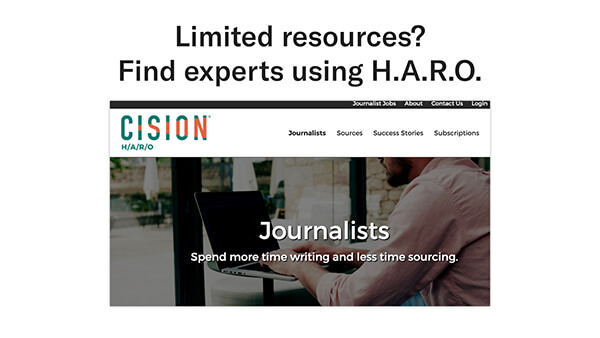
So basically, what you do there is you’re going to want to ask a really detailed question, and you’re going to get a lot of responses back.

Depending on the answer or the question that you ask, you’re going to have to probably sift through a lot of bad answers. So that’s just kind of one caveat to using the Help a Reporter Out method. But occasionally, you’ll get that diamond in the rough here that can help elevate your piece, like Nitro College did here.

It looks like a little quote that they asked for that helps bring that extra trust signal and expertise to their piece.
So maybe you’re in this industry that is so boring that all the good answers are gone. Maybe there are no good questions to ask. Totally fine.
That brings me to step four. If that’s the case, change the medium.
4. Change the Medium
A good way to think about this would be if you can look at what the SERP is telling you, can you see what types of content the other competitors are doing?

Maybe they’re listing the top 10 reasons. So in this example for how to buy a house we’re seeing 10 steps to buy a house, a stepwise process like this.

So maybe you can pivot it and do a visual guide, an infographic.
I’ll give you another example in the solar energy provider industry. So this example looks at how wind turbines work.
Looking at this, looking at this SERP, what we’re seeing is energy.gov is ranking.

And we’re seeing a lot of, kind of stock imagery, nothing overly interesting and a lot of text, like, kind of like my first tip, where you are looking at those walls of text.
But we also see that going up against energy.gov, we have to do something new. We have to change the medium. So what did they do?
Saveonenergy created this great animated infographic that looks at how wind turbines work.

It ended up getting them 99 links in the solar energy industry, which is pretty killer. They also got links from educational sites, from where their customers might be, where it’s going to help raise that domain authority.
It’s also now ranking in the top five for how wind turbines work.

So how can you do something like this? How do you change the medium in your industry?
How can you do it?
Well, like I said, look at the competitive landscape, look at what your competitors are doing.
As a good content marketer, you should know the different tactics that your competitors are trying because you’re always going to want to try to one up them, right? You want to stay competitive. So you have to know what other people are doing.
This is an example from Ryan Charles of HireAHelper. He actually spoke at the SearchLove last year and I was really inspired by this piece that they did. They looked at this idea of how to pack certain items. So how to pack a mixer, how to pack your plates, etc.
They saw on the SERPs that these are crowded SERPs with a lot of lists, stepwise-type content out there. So they decided to change the medium and create this video series about how to pack items.

And it did really well for them. This is just a great example of changing the medium there to stay competitive.
Maybe you don’t have the resources to create a video like this, to create an animated infographic. Totally cool.
That brings me to step five, tip five, which is leveraging the free data that’s out there and specifically making the user the star.
5. Leverage Free Data
There’s tons of free data out there. I will share with you a link to my 40 free data sources. And this is just a list of 40 data sources that exist out there that we’ve used.
I’ll show you an example. Say you’re looking at the National Highway Traffic Safety Authority site. Basically, they collate this data from the U.S. Department of Transportation.
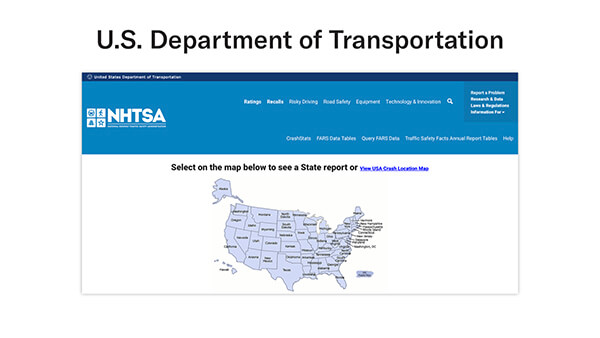
So you can go in, look at a state by state breakdown. It’ll tell you things like fatalities, crashes, accidents.

Then you can repurpose something like this into a piece, a data study, like Instamotor did here where they looked at the safest times to drive.

Here’s another great piece, though, that I want to share in the, probably mother of all boring industries. And that’s the law industry. (Probably gives insurance a good run for its money in how boring it can be.)
But this is a piece from Gotocourt. So it’s an Australian lawyer search site. And basically, what they did was they took data from the CrimeNet database, and they created this great piece that tells you how criminal your name is.

So, how many times, or, how likely it is that your name appears on their list? You type in your name, for instance you type in Vincent, and it shows you that it’s the 11th most criminal name in Australia.

(But, that’s Australia, hopefully not America!)
But, this piece did really well for them in a tough industry. It got them a lot of high-end news placements in Australia, which is what they want.

So how can you do it? How do you make the user the star? How do you leverage that free data to really get them involved?
How can you do it?
I think you want to give them something to share about themselves. So this is a great segue into this other piece that I love from the New York Times.
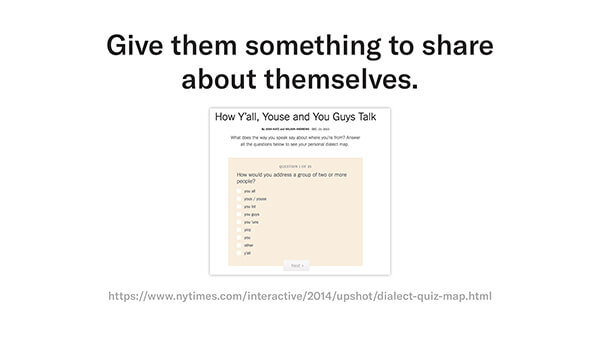
They created this dialect quiz. (It’s my all-time favorite piece. I talked about this all the time to anyone I can.)
I think it does a really good job of making this tie to a person on a personable level.
So basically, they ask you how you pronounce certain things. And by doing so, based on your answer, they then show you this little heat map where it shows you where it thinks you’re from.

I think this idea of kind of giving you something to compare yourself to others, I think that’s something that we really like as people. And for content creators, it works really well.
I don’t know if you’ve ever seen this or have been on Twitter, and you can click on a Twitter poll and it immediately will show you the answers and show you how you compare to other people.

This is a great trigger to share because you want to show off where you stand as a person, but then also how you compare to others. These are all great kind of shareability, linkability signals.
So you don’t necessarily have to use free data if you don’t want to.You can also collect your own data, which is also probably even better because it’s proprietary data that you could reuse.
Google Surveys is a great vehicle for this. It’s not necessarily free, but it’s a good kind of entry level surveying platform.

Okay. So what happens if your industry is so boring that even the data is boring?
Well, that brings me to step six. And that is to take a step out of your immediate industry.
6. Take a Step Out of Your Immediate Industry
So tip six, taking a step out and finding these tangential markets that exist right beyond yours. So, I want to give you an example here. So let’s look at this industry VoIP communication, VoIP phones. (This stands for Voice over Internet Protocol.)
If this is your industry, you’re thinking of physical phones, you maybe sell these phones. Can you take a step back out into kind of a more general business communication area?
I think that’s something that maps well if you’re talking about a tangential market is just general business communication.

So GetVoIP, a VoIP website, basically decided to do that and created this piece where they looked at the 25 most common business buzzwords. Again, this is playing in that business communication space, and still has that tie into communication.
They looked at using Google’s Ngram Viewer, which collates book data from their whole database, and they looked at how frequently certain buzzwords were used over time. So “low-hanging fruit” here has increased in usage almost 1,000% over the past 30 years.

This piece did really well for them. It got them a lot of links in the news areas, business, HR sites. These are all areas that are probably going to be interested in buying VoIP phones or reviewing VoIP phones, reading reviews of VoIP phones, which again is what GetVoIP is as a site. So this works out well for them.
It got 31 links in a tough industry.

So how can you do something like this?
How can you do it?
You want to start by trying to map out your industry, figure out where it fits in the landscape, and then try to take a step out, and find those tangential markets. The caveat to this is that you don’t want to be getting tons and tons of links from areas where your customers aren’t going.

If you’re finding that’s happening and you’re getting a lot of links that aren’t relevant to your industry at all, this probably won’t work and it can end up hurting you.
This can feel risky to some people, so maybe you don’t want to take a step too far out of your industry. So that brings me to my last tip, tip seven. And that’s the idea of porting other ideas into your industry.
7. Port Other Ideas Into Your Industry
You could probably boil this whole talk down to this main takeaway, which is going to be for me, as a content marketer, you need to be open to taking inspiration from all around you.

I just showed you a ton of great examples. And these are ones that you should be looking at, and looking into, and trying to figure out what it is you like about these ideas.
As a content marketer, other ways to take inspiration are subscribing to newsletters.

You can also build lists on Twitter and follow people that you know are sharing great content.
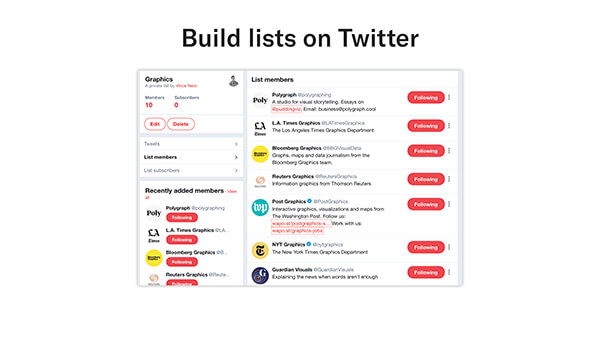
Try new sites like New York Times, Washington Post, they put out great content all the time.
They do year-end round-ups which I can share some links to. Great inspiration!

Try Reddit’s subreddit like Data is Beautiful. Those are two subreddits where I find inspiration from all the time.
Sort it by the top, look at the best viewed, best rated ones of all time, or, look at the new ones from the day; look at the hot ones, the trending ones.
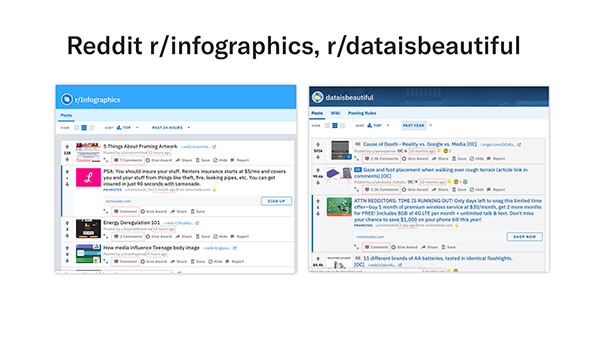
You could set up a Feedly account and put all of those Reddit links into there! Put all the sites that you like that create great content, and just look at them every single day.

SparkToro is a great new tool that you can check out, and that’ll show you trending topics, trending articles in the industry.

Shameless plug to follow me on Twitter.
I force myself to analyze it. So, I’m not just saying, “Hey, this is a great piece.” I’m saying, “Hey, this is a great piece, and here’s why.” “Here are four reasons why.”

You can probably - and you should be if you’re in a big team - encouraging your team to do the same type of thing.
At Webcore Hub, we do that all the time. It’s a great collaborative environment where people are sharing these pieces with each other all the time.

Understand What Makes Content Great
So, what it comes down to, like I said, is taking inspiration from all around you and asking yourself what it is you like about this content, not just that you like it.

What is it that you like about it? What makes it great content?
Because if you can do that, if you can get into that mindset all the time, you’re going to stop seeing your industry as being a boring industry.

And you’re just going to start making great content.

Let me know what you think in the comments. Please share other pieces that give you inspiration in the comments. I’d love to see them. So, thanks again.


